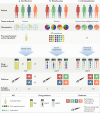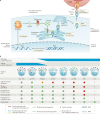Towards new horizons: characterization, classification and implications of the tumour antigenic repertoire
- PMID: 32572208
- PMCID: PMC7306938
- DOI: 10.1038/s41571-020-0387-x
Towards new horizons: characterization, classification and implications of the tumour antigenic repertoire
Abstract
Immune-checkpoint inhibition provides an unmatched level of durable clinical efficacy in various malignancies. Such therapies promote the activation of antigen-specific T cells, although the precise targets of these T cells remain unknown. Exploiting these targets holds great potential to amplify responses to treatment, such as by combining immune-checkpoint inhibition with therapeutic vaccination or other antigen-directed treatments. In this scenario, the pivotal hurdle remains the definition of valid HLA-restricted tumour antigens, which requires several levels of evidence before targets can be established with sufficient confidence. Suitable antigens might include tumour-specific antigens with alternative or wild-type sequences, tumour-associated antigens and cryptic antigens that exceed exome boundaries. Comprehensive antigen classification is required to enable future clinical development and the definition of innovative treatment strategies. Furthermore, clinical development remains challenging with regard to drug manufacturing and regulation, as well as treatment feasibility. Despite these challenges, treatments based on diligently curated antigens combined with a suitable therapeutic platform have the potential to enable optimal antitumour efficacy in patients, either as monotherapies or in combination with other established immunotherapies. In this Review, we summarize the current state-of-the-art approaches for the identification of candidate tumour antigens and provide a structured terminology based on their underlying characteristics.
Conflict of interest statement
S.P.H. has acted as an advisory board member for Abbvie, Bristol–Myers Squibb, MSD and Roche, and is a co-inventor of several patents owned by Immatics Biotechnologies. M.W.L. is a co-inventor of several patents owned by Immatics Biotechnologies, and has acted as a consultant and/or advisory board member for Boehringer Ingelheim. H.-G.R. has ownership interest (including shares) in CureVac, Immatics Biotechnologies and Synimmune, is a co-inventor and/or has shared interests in several patents held by CureVac, Immatics Biotechnologies and Synimmune, and is a co-inventor and shares the patent for the adjuvant candidate XS15. P.B. has acted as a consultant or advisory board member for Amgen, AstraZeneca, Bristol–Myers Squibb, MSD and Roche, has received speaker’s fees from Abbvie, AstraZeneca, Bristol-Myers Squibb, and MSD, and has ownership interests in Immatics Biotechnologies.
Figures




References
-
- Schwartz RS. Paul Ehrlich’s magic bullets. N. Engl. J. Med. 2004;350:1079–1080. - PubMed
-
- Thomas ED, Lochte HL, Jr., Lu WC, Ferrebee JW. Intravenous infusion of bone marrow in patients receiving radiation and chemotherapy. N. Engl. J. Med. 1957;257:491–496. - PubMed
-
- Kolb HJ, et al. Donor leukocyte transfusions for treatment of recurrent chronic myelogenous leukemia in marrow transplant patients. Blood. 1990;76:2462–2465. - PubMed
-
- Edinger M, et al. CD4+CD25+ regulatory T cells preserve graft-versus-tumor activity while inhibiting graft-versus-host disease after bone marrow transplantation. Nat. Med. 2003;9:1144–1150. - PubMed
Publication types
MeSH terms
Substances
LinkOut - more resources
Full Text Sources
Other Literature Sources
Medical
Research Materials

